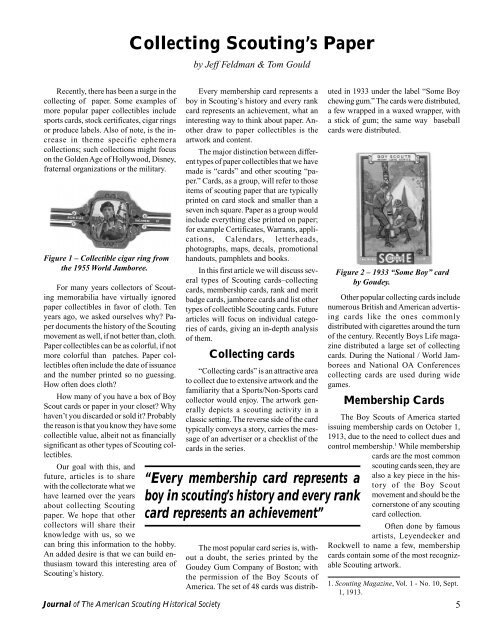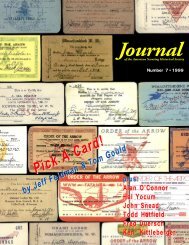Journal 6.PM - Gilwell.com!
Journal 6.PM - Gilwell.com!
Journal 6.PM - Gilwell.com!
You also want an ePaper? Increase the reach of your titles
YUMPU automatically turns print PDFs into web optimized ePapers that Google loves.
Collecting Scouting’s Paperby Jeff Feldman & Tom GouldRecently, there has been a surge in thecollecting of paper. Some examples ofmore popular paper collectibles includesports cards, stock certificates, cigar ringsor produce labels. Also of note, is the increasein theme specific ephemeracollections; such collections might focuson the Golden Age of Hollywood, Disney,fraternal organizations or the military.Figure 1 – Collectible cigar ring fromthe 1955 World Jamboree.For many years collectors of Scoutingmemorabilia have virtually ignoredpaper collectibles in favor of cloth. Tenyears ago, we asked ourselves why? Paperdocuments the history of the Scoutingmovement as well, if not better than, cloth.Paper collectibles can be as colorful, if notmore colorful than patches. Paper collectiblesoften include the date of issuanceand the number printed so no guessing.How often does cloth?How many of you have a box of BoyScout cards or paper in your closet? Whyhaven’t you discarded or sold it? Probablythe reason is that you know they have somecollectible value, albeit not as financiallysignificant as other types of Scouting collectibles.Our goal with this, andfuture, articles is to sharewith the collectorate what wehave learned over the yearsabout collecting Scoutingpaper. We hope that othercollectors will share theirknowledge with us, so wecan bring this information to the hobby.An added desire is that we can build enthusiasmtoward this interesting area ofScouting’s history.<strong>Journal</strong> of The American Scouting Historical SocietyEvery membership card represents aboy in Scouting’s history and every rankcard represents an achievement, what aninteresting way to think about paper. Anotherdraw to paper collectibles is theartwork and content.The major distinction between differenttypes of paper collectibles that we havemade is “cards” and other scouting “paper.”Cards, as a group, will refer to thoseitems of scouting paper that are typicallyprinted on card stock and smaller than aseven inch square. Paper as a group wouldinclude everything else printed on paper;for example Certificates, Warrants, applications,Calendars, letterheads,photographs, maps, decals, promotionalhandouts, pamphlets and books.In this first article we will discuss severaltypes of Scouting cards–collectingcards, membership cards, rank and meritbadge cards, jamboree cards and list othertypes of collectible Scouting cards. Futurearticles will focus on individual categoriesof cards, giving an in-depth analysisof them.Collecting cards“Collecting cards” is an attractive areato collect due to extensive artwork and thefamiliarity that a Sports/Non-Sports cardcollector would enjoy. The artwork generallydepicts a scouting activity in aclassic setting. The reverse side of the cardtypically conveys a story, carries the messageof an advertiser or a checklist of thecards in the series.“Every membership card represents aboy in scouting’s history and every rankcard represents an achievement”The most popular card series is, withouta doubt, the series printed by theGoudey Gum Company of Boston; withthe permission of the Boy Scouts ofAmerica. The set of 48 cards was distributedin 1933 under the label “Some Boychewing gum.” The cards were distributed,a few wrapped in a waxed wrapper, witha stick of gum; the same way baseballcards were distributed.Figure 2 – 1933 “Some Boy” cardby Goudey.Other popular collecting cards includenumerous British and American advertisingcards like the ones <strong>com</strong>monlydistributed with cigarettes around the turnof the century. Recently Boys Life magazinedistributed a large set of collectingcards. During the National / World Jamboreesand National OA Conferencescollecting cards are used during widegames.Membership CardsThe Boy Scouts of America startedissuing membership cards on October 1,1913, due to the need to collect dues andcontrol membership. 1 While membershipcards are the most <strong>com</strong>monscouting cards seen, they arealso a key piece in the historyof the Boy Scoutmovement and should be thecornerstone of any scoutingcard collection.Often done by famousartists, Leyendecker andRockwell to name a few, membershipcards contain some of the most recognizableScouting artwork.1. Scouting Magazine, Vol. 1 - No. 10, Sept.1, 1913.5



